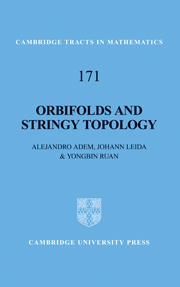Introduction
Published online by Cambridge University Press: 05 October 2009
Summary
Orbifolds lie at the intersection of many different areas of mathematics, including algebraic and differential geometry, topology, algebra, and string theory, among others. What is more, although the word “orbifold” was coined relatively recently, orbifolds actually have a much longer history. In algebraic geometry, for instance, their study goes back at least to the Italian school under the guise of varieties with quotient singularities. Indeed, surface quotient singularities have been studied in algebraic geometry for more than a hundred years, and remain an interesting topic today. As with any other singular variety, an algebraic geometer aims to remove the singularities from an orbifold by either deformation or resolution. A deformation changes the defining equation of the singularities, whereas a resolution removes a singularity by blowing it up. Using combinations of these two techniques, one can associate many smooth varieties to a given singular one. In complex dimension two, there is a natural notion of a minimal resolution, but in general it is more difficult to understand the relationships between all the different desingularizations.
Orbifolds made an appearance in more recent advances towards Mori's birational geometric program in the 1980s. For Gorenstein singularities, the higher-dimensional analog of the minimal condition is the famous crepant resolution, which is minimal with respect to the canonical classes.
- Type
- Chapter
- Information
- Orbifolds and Stringy Topology , pp. vii - xiiPublisher: Cambridge University PressPrint publication year: 2007

